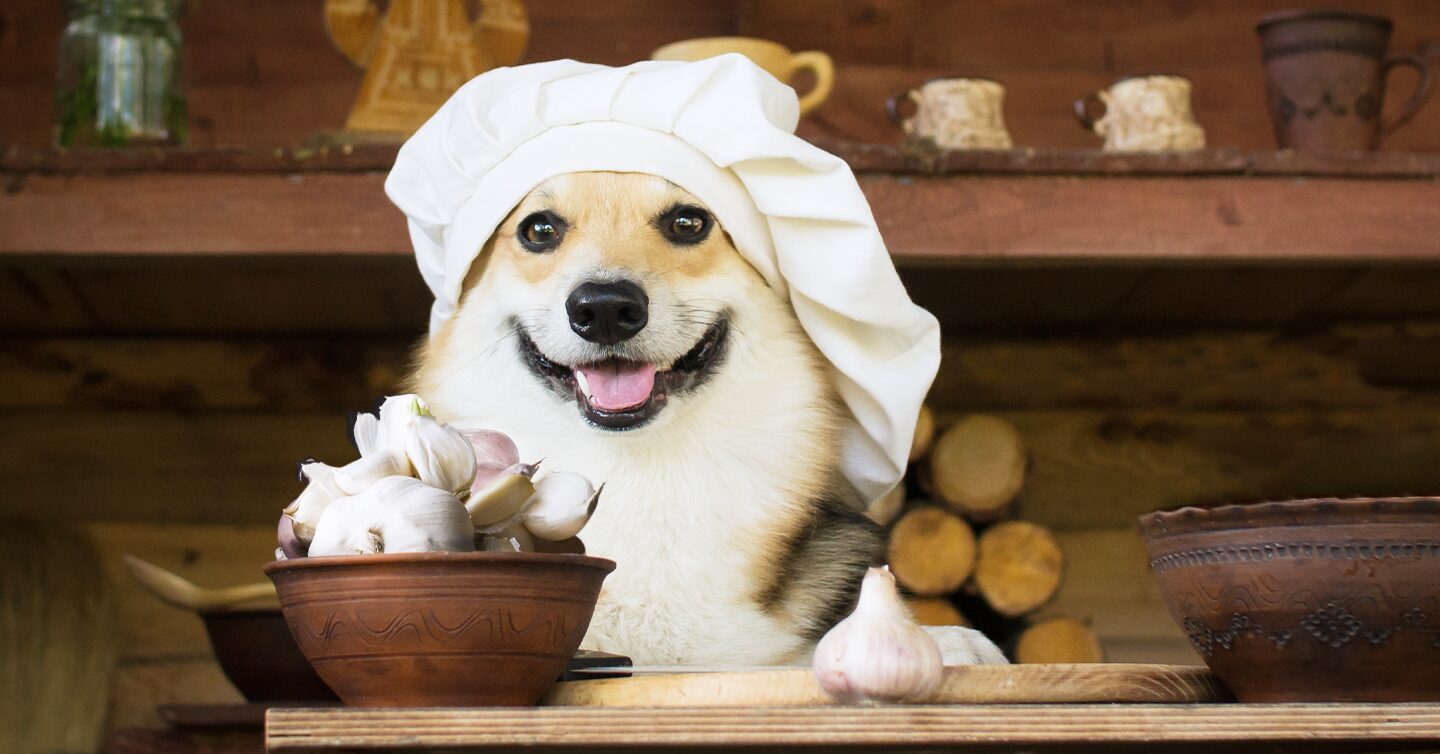Key Points:
- No, dogs should not eat garlic as it can cause toxicosis and anemia.
- Despite potential health benefits in humans, garlic poses risks to dogs.
- Preference is irrelevant, as garlic is harmful regardless of a dog’s liking.
- Dogs should avoid all forms of garlic, including raw, cooked, and powder.
- Even small amounts of garlic can be dangerous for dogs.
For centuries, humans have known that garlic has medicinal value. It makes sense, then, to assume garlic is also good for dogs. However, its safety depends on many factors.
In general, garlic is not safe for your dog. But let’s dive into why it is or isn’t – and see if it’s okay for your dog.
Both sides of the garlic story
Some people will tell you that garlic is great as a flea and tick repellent. That may be true – it changes the smell of your dog’s skin, causing fleas to avoid it. But studies are inconclusive on this point. Some dog parents say it works, while others say it doesn’t. In the end, you need to decide if the benefits of using garlic are greater than the risks.
From a holistic standpoint, the medicinal benefits of garlic are much the same for dogs as they are for us humans. Garlic lowers cholesterol – which is great for overweight dogs – reduces inflammation, lowers blood pressure, and boosts the immune system. However, its benefits depend entirely on the type of garlic and dosage given. It’s VERY important to talk to your vet prior to giving your dog any garlic.
Let’s look at the traditional veterinary stance on garlic:
There was a study done that investigated the incidence of hemolytic anemia in dogs that were given garlic extract. This study is controversial, because only four dogs provided the data. Nonetheless, it concluded that garlic caused harmful changes in the blood cells of dogs, and determined garlic is not safe for them.
Veterinarians and poison control organizations all agree that garlic is not safe for dogs. The risks outweigh the benefits, making garlic, or any plant in the Allium family toxic enough to cause harm to your dog or cat. (Cats are 6 times more likely than dogs to get garlic poisoning!)
Let’s see why.
Pet Pro Tip: If you have a dog that is prone to ‘snacksidents’ – you should consider getting a dog insurance plan as soon as possible. It can help you afford the best care in the future by covering eligible vet bills for digestive illnesses, toxic ingestion, and more.
Garlic, or Allium Sativum
Garlic is from the Allium family of root vegetables. Onions, leeks, and chives are also members of this family. They all contain an organic compound called n-propyl disulfide, which causes oxidative damage to red blood cells and leads to hemolytic anemia. Garlic contains 5-10 times more of the compound than onions, leeks, chives, or shallots.
We find this toxic compound in all parts of allium plants. Unfortunately for dogs (and cats), they don’t have the digestive enzyme capable of processing it. Most of the time, undigested parts of food get pooped out, but not thiosulfates. They hang around and cause havoc in your dog’s body. They can even build up.
Thiosulfates attach to your dog’s red blood cells – the ones that carry oxygen through the body. Once this happens, the red blood cells become damaged and form clumps called Heinz bodies. The body thinks the damaged cells are invaders, and it destroys them faster than your dog’s body can produce more. We call this hemolysis, or the destruction of red blood cells.
Once this begins, if left unchecked, your dog will go into hemolytic anemia. There’s not enough oxygen being carried throughout the body to keep it functioning. The symptoms of anemia can appear quickly, but it’s more common for the first symptoms to appear a few days after a dog ingests a toxic amount of garlic. Table scraps are the most common cause of garlic poisoning.
Signs of hemolytic anemia are:
- Lethargy
- Abdominal pain
- Decreased stamina or even fainting after or during exercise
- Loss of appetite
- Pale gums and drooling
- Elevated heart rate or respiratory rates (rapid breathing)
- Vomiting
- Diarrhea
- Loss of coordination (ataxia)
- Discolored urine
A dog suffering from these symptoms needs immediate medical attention to avoid kidney failure or even death. While it’s rare for dogs to die from eating garlic, Japanese breeds like Shiba Inu, Spitz, Chin, and Akita seem to be more prone to garlic toxicity. If you’d like to know more about allium family plants, go here.
Is there any amount of garlic that’s safe for my dog?
All dogs eat human food they shouldn’t, and garlic is on the list. While there’s controversy, everyone agrees that the toxicity of garlic depends on the type and amount ingested, as well as the size and breed of the dog involved.
If you lean more toward holistic views, you might consider daily amounts of raw garlic to be safe for your dog. These amounts of garlic provide preventative health benefits, boosting their immune system, improving their heart function, protecting them from fleas and ticks, and reducing inflammation.
Here’s a breakdown of safe daily amounts of fresh garlic from Dr. Pitcairn, author of “The Complete Guide to Natural Health for Dogs and Cats.”
10 to 15 pounds: .5 clove
20 to 40 pounds: 1 clove
45 to 70 pounds: 2 cloves
75 to 90 pounds: 2.5 cloves
100 pounds +: 3 cloves
Traditional veterinary medicine states that 15-30 grams of garlic per kg of body weight can produce a harmful chain of events in your dog’s body. With a clove of garlic weighing around 3-7 grams, that’s a large amount of garlic.
Chances are, if your dog gobbles down a hunk of your garlic bread, the small amount of garlic on it won’t cause them discomfort, other than some gas. However, if it happens regularly, or your dog eats a couple of cloves of garlic he nabbed from the counter, there could be trouble.
What happens when a dog gets garlic toxicity?
After your vet examines your dog for signs on their body’s exterior, they’ll run lots of tests to check for Heinz bodies, dehydration, kidney function, and oxygen levels.
It’s vitally important to keep their organs and body systems functioning. Some dogs may require oxygen therapy. This allows red blood cells that are still working to carry more oxygen with less effort. A vet may also give your dog powerful antioxidants to further help their red blood cells fight off damage from thiosulfates.
Depending on the severity of the anemia, IV fluids and possibly a blood transfusion may be necessary. Again, it’s rare for dogs to die from eating garlic, but immediate medical care is necessary if you suspect your sneaky snacker has ingested more than a tiny amount of it – or if you see symptoms.
What dogs should avoid all garlic and allium root vegetables?
Anemic Dogs: Dogs already diagnosed with anemic conditions should avoid garlic or any member of the allium family of vegetables.
Japanese Dog Breeds: Japanese Chins, Akita, Sheba Inu, and Spitz are all more susceptible to garlic toxicity or poisoning.
Dogs with Lupus: Lupus is a disease that causes the dog’s immune system to attack body tissues and organs. We don’t think of it as a dog disease, but it is.
Puppies: Puppies don’t start producing red blood cells until they are 6-8 weeks old. You should never give puppies garlic, or any food containing allium vegetables.
Can I feed my dog wild garlic, garlic powder or garlic oil?
Wild garlic is an allium root vegetable, and all parts of the plant are toxic. Garlic supplements are available that are safer if you and your vet have decided your dog can benefit from garlic supplementation.
Concentrated versions of garlic – including garlic oil and garlic powder – are more toxic to your dog than raw garlic.
Is garlic safe for your dog?
There are two camps on the safety of feeding garlic to dogs. The holistic view is that it provides health benefits, and while the traditional view is that it isn’t safe. The best advice we can give is to check with your vet BEFORE you give your dog anything that contains garlic. Since dog sizes vary, and dog breed predispositions also vary, it’s better to be safe than sorry.If your dog eats garlic and you’re concerned, call your vet or contact the ASPCA Pet Poison Helpline immediately.
Safe ways to feed your dog pumpkin
Raw pumpkin: When steamed or roasted and cut into small pieces, raw pumpkin can be a great treat for your dog.
Canned: You can find organic canned pumpkin in the supermarket that only contains fresh pumpkin. Not only is this a healthy addition to your pup’s kibble but is also known to help slow or stop diarrhea in dogs.




